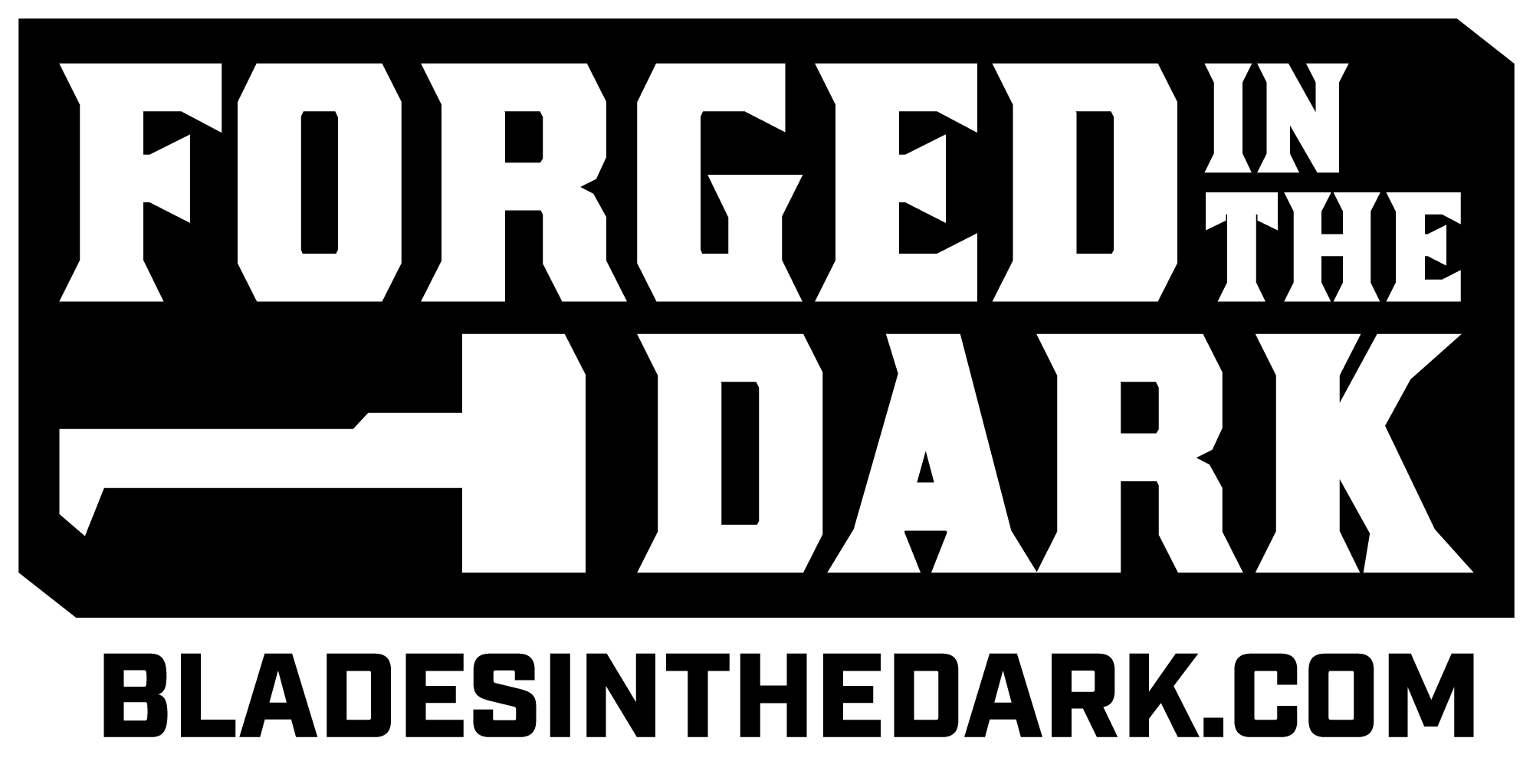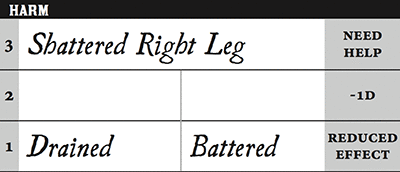Consequences & Harm 
Enemy actions, bad circumstances, or the outcome of a roll can inflict consequences on a PC. There are five types.
A given circumstance might result in one or more consequences, depending on the situation. The GM determines the consequences, following from the fiction and the style and tone established by the game group.
Reduced Effect
This consequence represents impaired performance. The PC’s action isn’t as effective as they’d anticipated. You hit him, but it’s only a flesh wound. She accepts the forged invitation, but she’ll keep her eye on you throughout the night. You’re able to scale the wall, but it’s slow going—you’re only halfway up. This consequence essentially reduces the effect level of the PC’s action by one after all other factors are accounted for.
Complication
This consequence represents trouble, mounting danger, or a new threat. The GM might introduce an immediate problem that results from the action right now: the room catches fire, you’re disarmed, the crew takes +1 heat from evidence or witnesses, you lose status with a faction, the target evades you and now it’s a chase, reinforcements arrive, etc.
Or the GM might tick a clock for the complication, instead. Maybe there’s a clock for the alert level of the guards at the manor. Or maybe the GM creates a new clock for the suspicion of the noble guests at the masquerade party and ticks it. Fill one tick on a clock for a minor complication or two ticks for a standard complication.
A serious complication is more severe: reinforcements surround and trap you, the room catches fire and falling ceiling beams block the door, your weapon is broken, the crew suffers +2 heat, your target escapes out of sight, etc. Fill three ticks on a clock for a serious complication.
Don’t inflict a complication that negates a successful roll. If a PC tries to corner an enemy and gets a 4/5, don’t say that the enemy escapes. The player’s roll succeeded, so the enemy is cornered… maybe the PC has to wrestle them into position and during the scuffle the enemy grabs their gun.
Lost Opportunity
This consequence represents shifting circumstance. You had an opportunity to achieve your goal with this action, but it slips away. To try again, you need a new approach—usually a new form of action or a change in circumstances. Maybe you tried to Skirmish with the diplomat to trap her on the balcony, but she evades your maneuver and leaps out of reach. If you want to trap her now you’ll have to try another way—maybe by Swaying her with your roguish charm.
Worse Position
This consequence represents losing control of the situation—the action carries you into a more dangerous position. Perhaps you make the leap across to the next rooftop, only to end up dangling by your fingertips. You haven’t failed, but you haven’t succeeded yet, either. You can try again, re-rolling at the new, worse position. This is a good consequence to choose to show escalating action. A situation might go from controlled, to risky, to desperate as the action plays out and the PC gets deeper and deeper in trouble.
Harm
This consequence represents a long-lasting debility (or death). When you suffer harm, record the specific injury on your character sheet equal to the level of harm you suffer. If you suffer lesser harm, record it in the bottom row. If you suffer moderate harm, write it in the middle row. If you suffer severe harm, record it in the top row. See examples of harm and the harm tracker, below.
Your character suffers the penalty indicated at the end of the row if any or all harm recorded in that row applies to the situation at hand. So, if you have “Drained” and “Battered” harm in the bottom row, you’ll suffer reduced effect when you try to run away from the guards. When you’re impaired by harm in the top row (severe harm, level 3), your character is incapacitated and can’t do anything unless you have help from someone else or push yourself to perform the action.
If you need to mark a harm level, but the row is already filled, the harm moves up to the next row above. So, if you suffered standard harm (level 2) but had no empty spaces in the second row, you’d have to record severe harm (level 3), instead. If you run out of spaces on the top row and need to mark harm there, your character suffers a catastrophic, permanent consequence (loss of a limb, sudden death, etc., depending on the circumstances).

Harm examples
To help you get a sense of how you might describe different levels of harm, here are few examples for each level. This includes some examples of long-lasting social harms that might be inflicted in sessions involving high-stakes diplomacy or intrigue.
Potentially Fatal (4): Electrocuted, Drowned, Lost Limb, Enemy of the State.
Severe (3): Impaled, Broken Leg, Shot in Chest, Badly Burned, Terrified, Disgraced, Shunned.
Moderate (2): Exhausted, Deep Lacerations, Concussion, Panicked, Beguiled, Out of Favor.
Lesser (1): Battered, Drained, Distracted, Scared, Confused, Embarrassed.
Harm like “Drained” or “Exhausted” can be a good fallback consequence if there’s nothing else threatening a PC (like when they spend all night Studying those old books, looking for any clues to their enemy’s weaknesses before he strikes).
Resistance and Armor
When your PC suffers a consequence that you don’t like, you can choose to resist it. Just tell the GM, “No, I don’t think so. I’m resisting that.” Resistance is always automatically effective—the GM will tell you if the consequence is reduced in severity or if you avoid it entirely. Then, you’ll make a resistance roll to see how much stress your character suffers as a result of their resistance.
You make the roll using one of your character’s attributes (Insight, Prowess, or Resolve). The GM chooses the attribute, based on the nature of consequences:
- Insight: Consequences from deception or understanding.
- Prowess: Consequences from physical strain or injury.
- Resolve: Consequences from mental strain or willpower.
Your character suffers 6 stress when they resist, minus the highest die result from the resistance roll. So, if you rolled a 4, you’d suffer 2 stress. If you rolled a 6, you’d suffer zero stress. If you get a critical result, you also clear 1 stress.
Ian’s character, Silas, is in a desperate Skirmish with several bruisers and one of them lands a blow with their switchblade. Since the position was desperate, the GM inflicts severe harm (modified by any other factors). They tell Ian to record level 3 harm, “Gut Stabbed” on Silas’s sheet. Ian decides to resist the harm, instead. The GM says he can reduce the harm by one level if he resists it. Ian rolls 3d for Silas’s Prowess attribute and gets a 5. Silas takes 1 stress and the harm is reduced to level 2, “Cut to the Ribs.”
Usually, a resistance roll reduces the severity of a consequence. If you’re going to suffer fatal harm, for example, a resistance roll would reduce the harm to severe, instead. Or if you got a complication when you were sneaking into the manor house, and the GM was going to mark three ticks on the “Alert” clock, she’d only mark two (or maybe one) if you resisted the complication.
You may only roll against a given consequence once.
The GM also has the option to rule that your character completely avoids the consequence. For instance, maybe you’re in a sword fight and the consequence is getting disarmed. When you resist, the GM says that you avoid that consequence completely: you keep hold of your weapon.
By adjusting which consequences are reduced vs. which are avoided, the GM establishes the overall tone of your game. For a more daring game, most consequences will be avoided. For a grittier game, most consequences will only be reduced with resistance.
The GM may also threaten several consequences at once, then the player may choose which ones to resist (and make rolls for each).
“She stabs you and then leaps off the balcony. Level 2 harm and you lose the opportunity to catch her with fighting.”
“I’ll resist losing the opportunity by grappling her as she attacks. She can stab me, but I don’t want to let her escape.”
Once you decide to resist a consequence and roll, you suffer the stress indicated. You can’t roll first and see how much stress you’ll take, then decide whether or not to resist.
Resistance Roll
- 1d for each Attribute rating.
You reduce or avoid the effects of the consequence (GM chooses).
Suffer 6 stress minus the highest die result.
Critical: Clear 1 stress.
Armor
If you have a type of armor that applies to the situation, you can mark an armor box to reduce or avoid a consequence, instead of rolling to resist.
Silas is taking level 2 harm, “Shot in the Side,” and the fight isn’t even over yet, so Ian decides to use Silas’s armor to reduce the harm. He marks the armor box and the harm becomes level 1, “Bruised.” If Silas was wearing heavy armor, he could mark a second armor box and reduce the harm again, to zero.
When an armor box is marked, it can’t be used again until it’s restored. All of your armor is restored when you choose your load for the next mission.
Death
There are a couple ways for a PC to die:
- If they suffer level 4 fatal harm and they don’t resist it, they die. Sometimes this is a choice a player wants to make, because they feel like it wouldn’t make sense for the character to survive or it seems right for their character to die here.
- If they need to record harm at level 3 and it’s already filled, they suffer a catastrophic consequence, which might mean sudden death (depending on the circumstances).
When your character dies, you have options:
- You can create a new agent to play. Maybe you “promote” one of the NPC experts on the crew to a PC, or create a brand new character who joins the crew.
